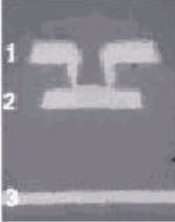SPRAA99C March 2008 – May 2021 AM3351 , AM3352 , AM3354 , AM3356 , AM3357 , AM3358 , AM3359 , AM4372 , AM4376 , AM4377 , AM4378 , AM4379 , OMAPL138B-EP , TMUX646
2.4 Via Density
Via density, as mentioned earlier, can be a limiting factor when designing high-density boards. Via density is defined as the number of vias in a particular board area. Using smaller vias increases the routability of the board by requiring less board space and increasing via density. The invention of the microvia, shown in Figure 2-5, has solved many of the problems associated with via density.
 Figure 2-5 Microvia Structure
Figure 2-5 Microvia StructureMicrovias are often created using a laser to penetrate the first few layers of dielectric. The laser can penetrate a 4-mil-thick dielectric layer, creating the 4 μm microvia shown in Figure 2-5. The layout designer can now route to the first internal board layer. Two layers (each 4 mils thick) can be laser-drilled, creating a 200 μm microvia diameter. In this case, routing to the first two internal layers is possible.